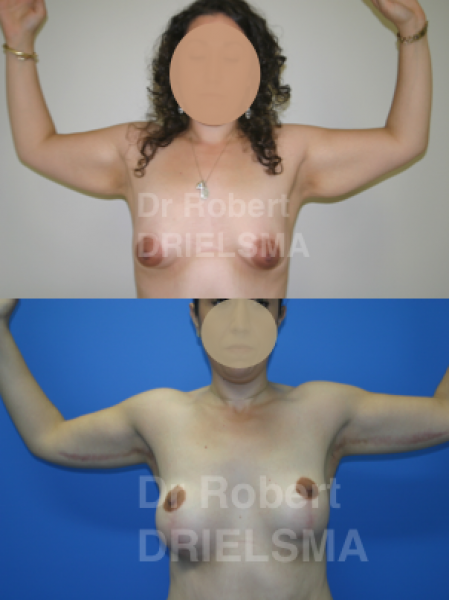An arm lift or brachioplasty is a body contouring procedure designed to deal with loose and sagging skin of the arms.
Loose and sagging arm skin, also known as “bingo arms” or “bat wings”, classically follow significant weight loss but can be due to general effects of ageing. The appearance often leads to embarrassment and concern and I see many patients keen to explore avenues of surgical correction.
Before and After Gallery
Arm Lift Surgery / Brachioplasty








-
Procedure Information
-
Performing the Arm Surgery (Brachioplasty)
-
Are there any risks?
Meet our Specialist Plastic Surgeon Dr Robert Drielsma MBBS, BSc(Med), FRACS
(AHPRA MED00001073756)
Dr Drielsma is an Australian trained Specialist Plastic Surgeon with over 30 years of extensive experience in plastic surgery of the face, breasts and body. He is a fellow of the Royal Australasian College of Surgeons (FRACS), a member of the Australian Society of Plastic Surgeons (ASPS) and a member of the Australian Society of Aesthetic Plastic Surgeons (ASAPS)

-
Next Step
- Next Step : Book your Initial Consultation
- What to Bring to your Surgeon Consultation
**Individual results may vary. All surgery carries risks.
You should seek a second opinion from an equally qualified Specialist Plastic Surgeon before proceeding with surgery.
Understanding Breast Reduction & Lift Procedures ✨
Did you know there are different techniques for breast reduction and lift? 🤔 Let’s break down the Lollipop vs. Anchorprocedures, and why Dr. Drielsma’s signature Lollipop Breast Reduction & Lift stands out!
🔹 Lollipop Breast Reduction & Lift: This technique uses a small incision around the areola and a vertical line beneath it, creating a “lollipop” shape. It’s perfect for those looking for a lift with minimal scarring and a more youthful, natural appearance.
🔹 Anchor Breast Reduction & Lift: The traditional method, involving three incisions: around the areola, down to the crease, and along the breast fold. This is ideal for patients with more significant sagging or excess skin.
✨ Why Dr. Drielsma’s Lollipop Technique?
Dr. Drielsma’s signature Lollipop Breast Reduction & Lift combines precision and artistry, giving you stunning results with less scarring and faster recovery. The technique is perfect for those who want to reduce volume and achieve a more firm, all natural and raised breast appearance.
Interested in learning more? DM us or book a consultation today! 🩺💕
.
.
.
#BreastReduction #BreastLift #LollipopLift #AnchorLift #DrDrielsma #SignatureTechnique #PlasticSurgery #BreastAugmentation #BodyConfidence

-Natural Shape
-Natural Size
-Natural Result
No implants. No boxy breasts.
Just Dr Drielsma’s signature, minimal scarring, lollipop breast reduction.
160 grams removed from the right
200 grams removed from the left
.
.
.
Individual results will vary according to factors including genetics, age, diet and exercise. All surgery carries risks and requires a recovery period and care regime including wearing of post operative garments. More information is available from the relevant procedure page on our website. You should seek a second opinion from a Specialist Surgeon before proceeding. Dr Drielsma is a Specialist Plastic Surgeon - AHPRA Registration: MED0001073756.
.
.
.
#breastreduction #breastlift #lollipopbreastreduction #lollipopbreastlift #internalbrasling #plasticsurgeonsydney #plasticsurgeonwagga #plasticsurgeoncanberra #plasticsurgeoncamden #bodylift #tummytuck

Busy day in the operating theatre.
.
.
.
#breastreduction #breastlift #lollipopbreastreduction #lollipopbreastlift #internalbrasling #plasticsurgeonsydney #plasticsurgeonwagga #plasticsurgeoncanberra #plasticsurgeoncamden #bodylift #tummytuck

The ⭐ combo = Dr Drielsma’s signature, minimal scarring breast reduction & lift.
No implants were used to archive this natural shape and elevation.
Tell us how much weight you think was removed from each breast.
Drop your guess 👇 in the comments.
📷 Post op photo taken 3 months after surgery.
.
.
.
Individual results will vary according to factors including genetics, age, diet and exercise. All surgery carries risks and requires a recovery period and care regime including wearing of post operative garments. More information is available from the relevant procedure page on our website. You should seek a second opinion from a Specialist Surgeon before proceeding. Dr Drielsma is a Specialist Plastic Surgeon - AHPRA Registration: MED0001073756.
#breastreduction #breastlift #lollipopbreastreduction #lollipopbreastlift #internalbrasling #plasticsurgeonsydney #plasticsurgeonwagga #plasticsurgeoncanberra #plasticsurgeoncamden #bodylift #tummytuck

Choosing to have cosmetic surgery is a very personal one and should be for you, not anyone else.
Individual results may vary. All surgeries carry potential risks and complications. You should seek the opinion of a fully qualified Specialist Plastic Surgeon before proceeding with surgery. Dr Drielsma is a fully qualified Specialist Plastic Surgeon. (AHPRA - MED0001073756)
.
.
.
#breastreduction #breastlift #lollipopbreastreduction #lollipopbreastlift #internalbrasling #plasticsurgeonsydney #plasticsurgeonwagga #plasticsurgeoncanberra #plasticsurgeoncamden #bodylift #tummytuck



 Before & After
Before & After











